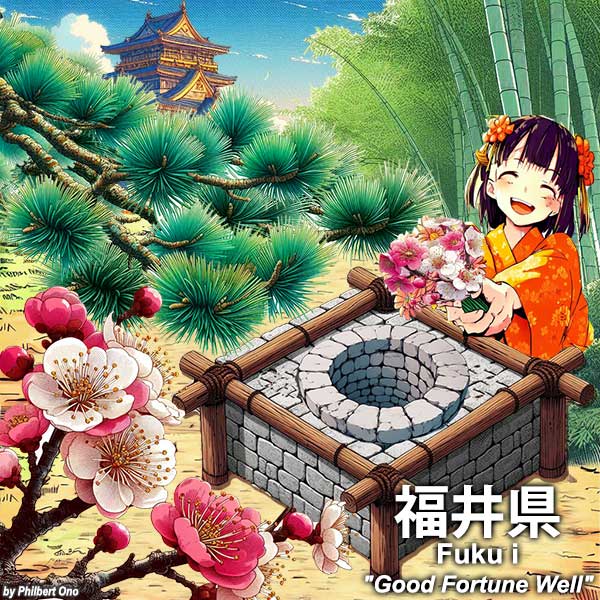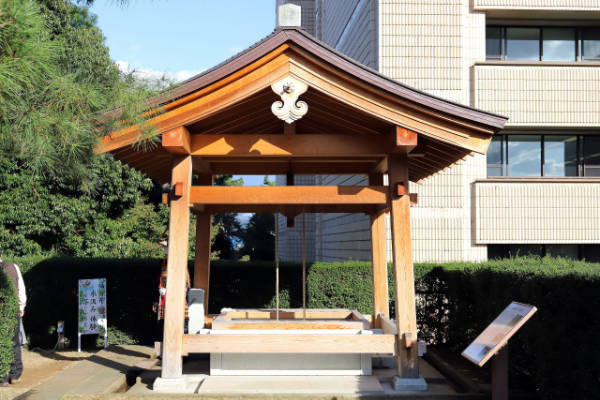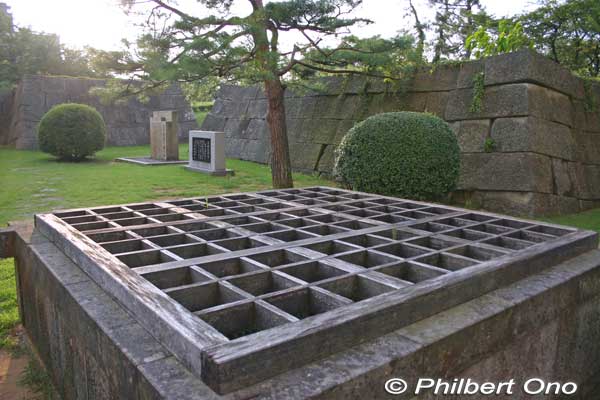FUKUI – Good Fortune Well 福井県

Fukui Prefecture was named after a water well named “Fuku-no-i” or “Good Fortune Well” (福の井) at Fukui Castle in central Fukui city. This well still exists and can be found on the main castle tower’s stone foundation (tenshudai 天守台). The main tower was destroyed by fire in 1669 and never rebuilt. Only the stone walls and foundation remain. Anyone can go and see the Fuku-no-i well.
The Fukui Castle site is open to the public as a public park and location of prefectural capital offices occupying the area where the castle palace once stood. No castle buildings remain today, only stone walls, stone foundations, and moats. A covered bridge called Orōkabashi Bridge (御廊下橋) was recently reconstructed.
Fukui Castle was originally named Kitanosho Castle (北ノ庄城) when it was built in 1601 as the base for the Fukui Domain (also called “Echizen”). The well was apparently already here when the castle was built.
In 1624, after Matsudaira Tadamasa (1598–1645 松平忠昌) took over the Echizen Domain as the third-generation daimyo and grandson of first Shogun Tokugawa Ieyasu, he renamed Kitanosho Castle as “Fukui Castle” using the kanji characters 福居 meaning “Good Fortune Here.”
He didn’t like the name “Kitanosho” since it contained the word “kita” meaning “north” (北). In his mind, “kita” was associated with haiboku (敗北) meaning “military defeat.” North was the direction where a defeated army would usually escape to.
Although there’s no clear explanation about why Tadamasa chose “Fukui,” we can imagine that he desired a more auspicious name. “Fuku” (good fortune) in names is quite common in Japan. (i.e. Fukushima, Fukuyama, Fukuoka, etc.)
It may have come from the name of the well which was named “Fukui no Ido” (福井の井戸) or Fukui’s Well. His domain was named “Fukui.” It’s hard to tell what was named “Fukui” first, the well, castle, or domain.
During the 17th century, the kanji characters used for “Fukui” was both 福居 and 福井. By around 1700, the kanji characters for Fukui officially became 福井 meaning “Good Fortune Well.”
On an old map of the castle dated 1775 (御城下絵図), the well is noted as “Fukui” (福井). During this time, the well was commonly called “Fuku-no-i” (福の井), apparently a special well at Fukui Castle.
During the medieval period, what would become Fukui Prefecture consisted of Wakasa Province and Echizen Province. In 1871, after the samurai domains were abolished, the future Fukui Prefecture consisted of seven smaller prefectures including the original Fukui Prefecture, Tsuruga Prefecture, and Asuwa Prefecture.
In 1876, the former Wakasa Province (Tsuruga, Obama, etc.) fronting the Sea of Japan merged into neighboring Shiga Prefecture, and northern Fukui (Fukui city, Ohno, Eiheiji, etc.) merged into Ishikawa Prefecture. However, both areas returned to Fukui Prefecture in 1881 to finally establish the Fukui Prefecture we know today. For five short years, landlocked Shiga Prefecture enjoyed an ocean coast, a fun fact in Shiga.
Since the prefectural capital was located in the original Fukui Prefecture, the newly merged prefecture retained the “Fukui” name.
The Fuku-no-i “Good Fortune Well” at Fukui Castle still functions as a water well. In 1948, the Fukui Earthquake damaged Fukui Castle’s stone walls in the main Honmaru keep. Although the well didn’t collapse, the well’s basin walls were damaged and later rebuilt.
In March 2017, major renovations on the well were completed including a Japanese-style shelter and bucket pulley built above it. The well’s basin walls and size were reverted back to the original specifications before the 1948 earthquake. It reuses the original well stones as much as possible while cracked stones were replaced.

The well basin is made of square concrete, but the well hole itself is round. The well is covered with a wooden lattice to prevent people from falling inside.
The well hole is currently 1.6 meter in diameter, 5.1 meters deep, and water depth is 2.1 meters. Next to the well is a water faucet providing drinkable well water.

Old province names: Echizen-no-Kuni + Wakasa-no-Kuni (越前国+若狭国)
*The AI-generated image is for illustrative purposes only and may not accurately depict any particular place in the prefecture.
Sources: https://www.pref.fukui.lg.jp/muse/Cul-Hist/kikaku/kako/2021/20210515_haihusiryou.pdf
https://www.pref.fukui.lg.jp/doc/sokou/kennto/fukunoi.html
Origin of other prefectural names (etymologies)
Overview | Aichi | Akita | Aomori | Chiba | Ehime | Fukui | Fukuoka | Fukushima | Gifu | Gunma | Hiroshima | Hokkaido | Hyogo | Ibaraki | Ishikawa | Iwate | Kagawa | Kagoshima | Kanagawa | Kochi | Kumamoto | Kyoto | Mie | Miyagi | Miyazaki | Nagano | Nagasaki | Nara | Niigata | Oita | Okayama | Okinawa | Osaka | Saga | Saitama | Shiga | Shimane | Shizuoka | Tochigi | Tokushima | Tokyo | Tottori | Toyama | Wakayama | Yamagata | Yamaguchi | Yamanashi